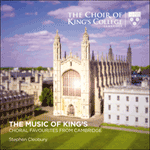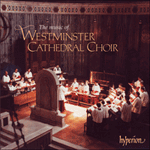
Welcome to Hyperion Records, an independent British classical label devoted to presenting high-quality recordings of music of all styles and from all periods from the twelfth century to the twenty-first.
Hyperion offers both CDs, and downloads in a number of formats. The site is also available in several languages.
Please use the dropdown buttons to set your preferred options, or use the checkbox to accept the defaults.

Why keep such a masterpiece hidden? The answer to this question lies in the strong Christian faith to which Martin adhered throughout his life. He was born into a fervently Christian family – his father was a Calvinist minister – and religious themes form the basis of much of his music, both choral and instrumental. Such an all-pervasive faith convinced him that the public airing of an aesthetic work expressing the very essence of Christianity was tantamount to blasphemy. As he wrote at the time of the Mass’s premiere: ‘I did not want it to be performed … I considered it … as being a matter between God and myself. I felt then that an expression of religious feelings should remain secret and removed from public opinion.’
There was a further reason for Martin’s reluctance to have the Mass performed. When he was ten he had heard a performance of Bach’s St Matthew Passion, an occasion which had so profoundly affected him that he decided there and then to devote his life to music. But if Bach was the catalyst to set Martin on the composing road, Bach was also the barrier which held Martin back from submitting his music to the public gaze. Beside the genius of Bach, Martin was convinced his own efforts would seem merely presumptuous – a belief he never fully shook off.
Coming from a Calvinist background Martin was not imbued with the Catholic tradition of the Mass with its associated plainchant melodies. There is no plainchant in Martin’s Mass, although its influence is obvious in the sinuous alto melody at the start of the Kyrie. Free-flowing, interweaving melodies, often sung antiphonally (as in the opening bars), create a vivid sense of streams of supplication in this movement while the calm, gentle opening to the Gloria, with the voices piling up in a sensation of awestruck wonder, leads into a movement in which frequent changes of time signature and syncopated cross-rhythms testify to the fascination with rhythm which led Martin to study and later teach rhythmic theory at the Jacques-Dalcroze Institute. Martin declared that the music for the words ‘et incarnatus est’ in the Credo was ‘very dear’ to him. The Credo, central to the Christian faith, displays Martin’s wonderful conciseness of word-setting; a conciseness which results in all five movements of the Mass being of roughly equal musical length. There is some subtle word-painting, with a gloriously luminous climax on ‘lumen de lumine’, and some truly ecstatic canonic writing for ‘Et resurrexit’ where the essentially intimate nature of the Mass is highlighted by this glorious moment being marked both dolce and piano. Above a gentle swaying cushion of harmony from the tenors and basses the sopranos intone with ever-increasing urgency the word ‘Sanctus’. After a sensuous, almost erotic, setting of the ‘Benedictus’ this movement concludes with one of the work’s few passages to be marked fortissimo.
And that is where Martin concluded his 1922 Mass. However, in 1926 he took the work out and added a deeply moving Agnus Dei in which the two choirs are used essentially as separate entities, the second maintaining a steady, regular movement while the first, largely in unison, moves with the kind of quasi-plainchant free-rhythmic flow heard in the Kyrie. Only with the final invocation of peace do both choirs join as one in a rich and moving conclusion to a work of unalloyed beauty.
from notes by Marc Rochester © 1998
Pourquoi cacher un tel chef-d’œuvre? La réponse réside dans la forte foi chrétienne à laquelle Martin adhéra tout au long de sa vie. Né dans une famille ardemment chrétienne – son père était pasteur calviniste –, il composa une musique chorale et instrumentale en grande partie fondée sur des thèmes religieux. Une telle foi omniprésente le persuada que faire connaître au public une œuvre esthétique exprimant l’essence même du christianisme équivalait à un blasphème. Comme il l’écrivit au moment de la première de sa Messe: «Je ne voulais pas qu’elle fût interprétée … Je la considérais … comme une affaire entre Dieu et moi. Je pensais alors que l’expression des sentiments religieux devait demeurer secrète et éloignée de l’opinion publique.»
Une autre raison présidait à sa répugnance à voir sa Messe interprétée: à l’âge de dix ans, il entendit la Passion selon saint Matthieu de Bach et en fut si profondément affecté qu’il décida sur-le-champ de vouer sa vie à la musique. Mais si Bach fut le catalyseur qui le mit sur la voie de la composition, il fut aussi l’obstacle qui l’empêcha de soumettre sa musique au regard du public. A côté du génie de Bach, Martin était convaincu que ses efforts sembleraient simplement présomptueux – une croyance dont il ne se départit jamais tout à fait.
Issu d’un milieu calviniste, Martin ne fut pas imprégné de la tradition catholique de la messes avec ses mélodies de plain-chant. Aussi sa Messe ne comporte-t-elle pas de plain-chant, même si l’influence de ce dernier est manifeste dans la sinueuse mélodie d’alto, au début du Kyrie. Des mélodies libres et entrelacées, souvent chantées antiphoniquement (comme dans les mesures initiales), créent dans ce mouvement une vive sensation de courants de supplication, tandis que l’ouverture calme, douce, du Gloria – où les voix s’amoncellent dans une sensation d’émerveillement impressionné – conduit à un mouvement dans lequel les fréquents changements d’indication de mesure et les contre-rythmes syncopés attestent la fascination de Martin pour le rythme, qui l’amena à étudier, puis à enseigner, la théorie rythmique à l’Institut Jacques-Dalcroze. Martin déclara que la musique pour les mots «et incarnatus est» du Credo lui était «très chère». Le Credo, crucial dans la foi chrétienne, illustre la merveilleuse concision de la mise en musique de Martin, concision qui se traduit par une durée musicale grosso modo identique des cinq mouvements de la messe. Un figuralisme subtil, avec un apogée superbement lumineux sur «lumen de lumine», côtoie une écriture canonique véritablement extatique pour «Et resurrexit», où la nature essentiellement intime de la messe est rehaussée par ce glorieux moment marqué dolce et piano. Par-dessus un coussin harmonique, doux et oscillant, exécuté par les ténors et les basses, les sopranos entonnent le mot «Sanctus», avec une urgence toujours croissante. Après une mise en musique sensuelle, quasi érotique, du «Benedictus», ce mouvement s’achève sur l’un des rares passages de l’œuvre marqués fortissimo.
Martin conclut ainsi sa Messe de 1922, à laquelle il ajouta cependant, en 1926, un Agnus Dei profondément émouvant, où les deux chœurs sont essentiellement utilisés comme des entités distinctes, le second maintenant un mouvement constant, régulier, tandis que le premier, en grande partie à l’unisson, se meut avec le type de flot rythmique libre, presque grégorien, entendu dans le Kyrie. Ce n’est que dans l’invocation de paix finale que les deux chœurs se rejoignent pour la conclusion riche et émouvante d’une œuvre à la beauté pure.
extrait des notes rédigées par Marc Rochester © 1998
Français: Hypérion
Warum versteckt man ein solches Meisterwerk? Die Antwort auf diese Frage liegt im starken christlichen Glauben, dem Martin sein Leben hindurch folgte. Er wurde in eine inbrünstige christliche Familie geboren – sein Vater war kalvinistischer Priester – und religiöse Themen bilden die Basis seiner choralen und instrumentalen Musik. Er war von einem solch alles erfüllendem Glauben gefangen, daß er die öffentliche Aufführung eines ästhetischen Werkes, das die Essenz des Christentums ausdrückte, als Gotteslästerung empfand. So schrieb er zur Uraufführung der Messe: „Ich wollte nicht, daß sie aufgeführt wird … Ich betrachte sie als … eine Angelegenheit zwischen Gott und mir. Ich war der Ansicht, daß der Ausdruck religiöser Gefühle von der öffentlichen Kritik verschlossen und ferngehalten werden sollte.“
Es gab einen weiteren Grund für die Weigerung Martins, die Messe aufführen zu lassen. Im Alter von zehn Jahren hörte er eine Aufführung von Bachs Matthäuspassion. Dieses Erlebnis beeinflußte ihn so grundlegend, daß er sich entschloß, sein Leben fortan der Musik zu widmen. Und wenn Bach einerseits der Auslöser für Martins Karriere als Komponist war, so stellte er auch andererseits die Grenze dar, die ihn davon abhielt, seine Musik der Öffentlichkeit zu präsentieren. Martin war nicht nur vom Genie Bachs überzeugt, sondern auch davon, daß seine eigenen Bemühungen lediglich vermessen erscheinen würden – eine Glaube, den er niemals völlig aufgab.
Da Martin aus einer kalvinistischen Familie stammte, war er nicht mit der katholischen Tradition der Messe mit ihren gregorianischen Gesangsmelodien vertraut. In Martins Messe gibt es keine gregorianischen Gesänge, ihr Einfluß ist allerdings in der gewundenen Altmelodie zu Beginn der Kyrie erkennbar. Frei fließende, ineinander verschlungene Melodien, häufig antiphonisch gesungen (wie in den Anfangstakten), schaffen ein lebendiges Gefühl flehentlicher Ströme in diesem Satz, während die ruhige und sanfte Eröffnung der Gloria mit sich auftürmenden Stimmen in eine Empfindung ehrfurchtsvoller Verwunderung in einen Satz führt, in der wechselnde Taktvorzeichen und synkopierte Gegenrhythmen ein Zeichen für die Faszination des Rhythmus darstellen und Martin schließlich dazu veranlaßten, am Jacques-Dalcroze-Institut Rhythmustheorie zu studieren und später selbst zu unterrichten. Martin erklärte, daß die Musik für die Worte „et incarnatus est“ im Credo für ihn „sehr teuer“ sei. Das Credo, zentral im christlichen Glauben, zeigt Martins wunderbare Präzision bei der Textunterlegung; eine Genauigkeit, die darin resultiert, daß alle fünf Sätze der Messe über die nahezu gleiche musikalische Länge verfügen. Es gibt feine Wortmalereien mit einem herrlich glänzenden Höhepunkt in „lumen de lumine“ sowie einige wahrhaft ekstatische Kanons für „Et resurrexit“, wobei das essentielle, intime Wesen der Messe durch jenen herrlichen Moment unterstrichen wird, der durch dolce und piano gekennzeichnet ist. Über einem sanft wiegenden Polster der Harmonie von Tenören und Bässen intonieren die Soprane mit steigernder Nachdringlichkeit das Wort „Sanctus“. Nach einer gefühlvollen, nahezu erotischen Inszenierung des „Benedictus“, schließt dieser Satz mit einer der wenigen fortissimo-Passagen dieses Werkes.
Und damit vollendete Martin 1922 seine Messe. 1926 fügte er jedoch ein zutiefst bewegendes Agnus Dei hinzu, in dem die beiden Chöre im wesentlichen als zwei voneinander getrennte Wesen eingesetzt werden, wobei der zweite eine stete, gleichmäßige Bewegung beibehält, während der erste, größtenteils in Einklang, mit quasi gregorianischen Gesängen frei-rhythmisch dahingleitet, wie in der Kyrie zu hören ist. Lediglich in der letztlichen Beschwörung des Friedens vereinigen sich beide Chöre zu einem reichen und bewegenden Finale eines in seiner Schönheit ungetrübten Werkes.
aus dem Begleittext von Marc Rochester © 1998
Deutsch: Atlas Translations
 The music of King's The music of King'sThis new recording presents nineteen opulently recorded treasures from the immense repertoire of this most august of choirs, everything from Baroque and Renaissance masterpieces to fresh arrangements of American and Chinese folk songs.» More |
 The music of Westminster Cathedral Choir The music of Westminster Cathedral Choir'A wonderful programme. Westminster Cathedral Choir excite, enthral and electrify under both James O'Donnell and his predecessor David Hill. It would make an ideal gift for any lover of the tradition' (Cathedral Music) 'Bargain of the month' ( ... » More |

